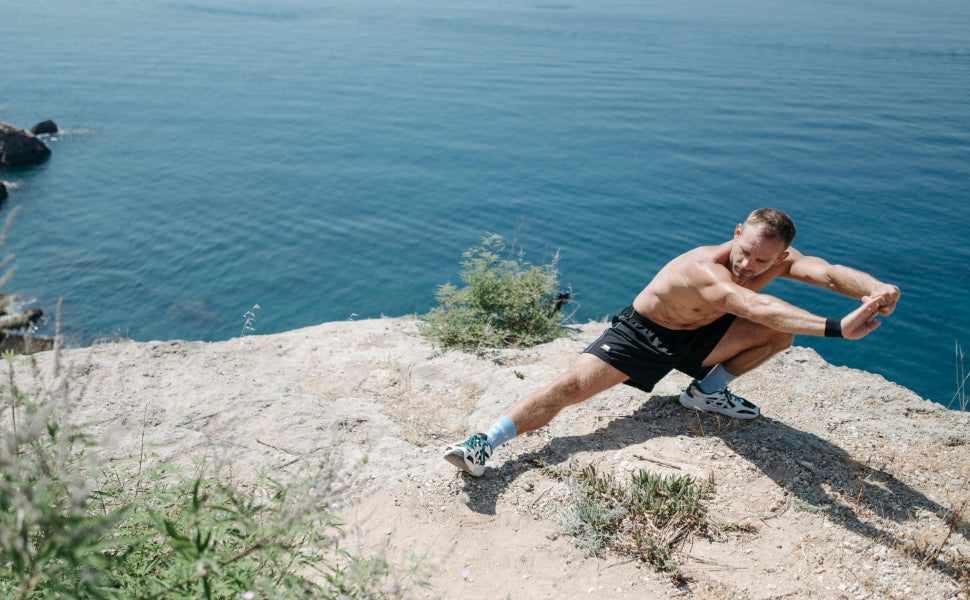10 Lifting Shoulder Protection Tips & Shoulder Support for Lifting 2024

Most of us want to smash this size building “Biceps and Triceps workouts.” But we often forget the potential risks involved with excessive weight lifting. Muscle tear, shoulder impingement pain, and rotator cuff injury are some of the common weightlifting injuries. Shoulder support for lifting can be a game-changer for the fitness freaks who are always gravitating towards weightlifting.
These shoulder braces and supports give protection and recovery by providing medical-grade compression and enhanced stability. Say goodbye to shoulder issues as we unveil the 10 most practical shoulder protection techniques. We’ll also be spilling tea on how to protect shoulder injuries with the help of shoulder support for lifting. Picture this: no shoulder issues and freedom to perform all your favorite lifting exercises.

Shoulder Mechanics and Injuries in Weightlifting
About 90%[1] of the dislocations and fractures happen because of free weightlifting. Let’s flip the script and understand the shoulder mechanics so we are aware of potential injuries that can occur while weightlifting.
1) Skeletal and Muscular Structure of the Shoulder
In the human body, the shoulder joint is the most mobile joint, allowing a range of motion. Therefore, it is also the most threatened joint to get injured during weightlifting. It has three bones:
- The humerus (upper arm bone)
- The scapula (shoulder blade)
- The clavicle (collarbone)
The tendons attach shoulder muscles to bones. The rotator cuff muscles (a group of four muscles) stabilize the shoulder and allow for its extensive motion range. And two muscles are more prone to injuries:
- Pectoralis major muscle
- Biceps brachii muscle
2) Causes and Mechanisms of Injuries
In weightlifting, there are three most common causes of injuries:
- Overhead weight training: This training involves lifting weights to the level of shoulders. After lifting the weight, it is then pressed overhead. It is the most common cause of shoulder pain and capsulolabral injuries.
- Bench pressing: It is a weight training exercise in which an individual lies horizontally on a weight training bench and presses a weight upward. It is also the most common cause of pectoralis major ruptures.
- Improper lifting techniques: Improperly lifting weights can lead to altered alignment of shoulder tissues, inflammation, and irregular movement. When the tendon is unable to move smoothly, it can result in pain in the shoulder region.
3) Common Types of Shoulder Injuries and Symptoms
Some of the most common types of shoulder injuries from lifting are:
- Cartilage Tear: Besides falling, cartilage tears can occur because of increased stress on the shoulders and doing the Cartilage tear again and again. The main symptom is pain and weakness in the shoulders when lifting your hand upwards.
- Frozen shoulder: When the connective tissue surrounding the shoulder joint tightens and thickens, it leads to pain and stiffness in the joints of the shoulder. Symptoms begin slowly and, over time, get worse.
- Rotator Cuff Tear: Prolonged overhead and weightlifting activities can cause progressive wear and tear of rotator cuff muscles.
- Impingement Pain: When we lift our arms above, the space between the humorous head and acromion gets smaller. Prolonged lifting activities can cause the compression of structures that lie in the space. It results in pain.
Basic Strategies and Tips for Shoulder Protection in Weightlifting
The purpose of applying basic strategies and tips for shoulder protection is to provide flexibility in muscles, mobility, and stability in the right places. Some of these strategies are:

1. Shoulder Warm-up Exercises
If we ever start a workout without warming up, we've likely learned that our muscles and joints require proper preparation before exerting maximum effort.
Our shoulders, in particular, can be easy to overlook during a warm-up. Simply swinging your arms back and forth a few times isn't enough to adequately warm them up. Try out these shoulder warm-up exercises for a great headstart:
- Banded Lateral Raise
- Banded Overhead Reach
- Scapular Slide
- Hand Walkout
- Crab Reach
- Lateral Plank Walk
- Scapular Pull-Up
- Scapular Push-Up
2. Correct Lifting Posture
It is said for a reason that the better the posture, the better the results. Learn to do each weightlifting activity properly while maintaining a good posture. Keep your back straight, and shoulders back, and ensure your head is aligned with your spine. A shoulder support can help maintain a correct lifting posture. If uncertain about it, ask a trainee or a specialist.
3. Control of Weight and Speed
Haste makes waste, so make sure to avoid performing exercises too quickly. Also, do not lift weights that are too heavy. Gradually increase the weight and focus on controlled, steady movements. It will reduce the risk of sudden stress on the shoulder joints.
4. Maintain Core Stability
A strong core gives us a stable foundation for all lifting exercises. When we engage our abdominal muscles, they help maintain a firm core to support our upper body and shoulders during lifts.
5. Avoid Dangerous Movements
Some movements, like behind-the-neck presses or excessive internal rotation, can place a lot of stress on the shoulder joint. It's a good idea to avoid these high-risk exercises. Instead, go for safer alternatives like front presses or lateral raises.
6. Avoid Over-training
Over-training can cause fatigue and increase the risk of injury. Always add adequate rest days between intense shoulder workouts. It will allow muscles and joints to recover.
7. Use Shoulder Support for Lifting
A great way to provide additional stability and protection to the shoulder joint is wearing shoulder support for lifting. Products like the Fivali Shoulder Compression Sleeve offer support and compression. They significantly reduce the risk of injury during intense lifting sessions.
8. Strengthen Shoulder Muscles
The best way to strengthen the shoulder muscles is by adding some exercises to your daily routine. Choose exercises that target the rotator cuff and shoulder stabilizers, such as external rotations and scapular retractions.
9. Nutrition and Recovery
Our body needs good fat, cholesterol, and protein for muscle repair and recovery. Ensure you consume enough vitamins, protein, and minerals to support shoulder health. Moreover, incorporating recovery techniques like icing, stretching, and foam rolling into the routine helps a lot.
10. Seek Professional Guidance
If you're new to weightlifting or have a history of shoulder problems from weightlifting, seek guidance from a fitness professional. They can provide personalized advice on proper technique, weight selection, and injury prevention strategies.
Fivali Shoulder Support for Lifting 2024

Ever thought about what could be the best shoulder brace for lifting weights that ensures optimal shoulder protection? Let me introduce you to Fivali’s range of shoulder support for lifting. These lifting braces are designed to provide the necessary stability and flexibility for intense lifting sessions.
1. Fivali Shoulder Compression Sleeve for Sports and Daily Lives
The Fivali Shoulder Compression Sleeve is ideal for both sports and daily activities. It offers excellent compression and support, reducing the risk of injuries and aiding in recovery. Its breathable and flexible material ensures comfort during extended use.
2. Fivali Compression Shoulder Brace for Fitness Breathable and Flexible
This shoulder support for lifting is specifically designed for fitness enthusiasts. It provides targeted compression to support the shoulder joint during heavy lifting. It comes with detachable compression straps making it a perfect fit.
3. Fivali Sports Shoulder Support Torn Rotator Cuff for Joint Stability
For those recovering from a rotator cuff injury, the Fivali Sports Shoulder Support for lifting is an excellent choice. It gives robust support to the shoulder joint. This shoulder brace for lifting promotes stability and reduces the risk of further injury. Its adjustable straps ensure a secure fit, catering to individual needs.
Protecting shoulders while lifting is the ultimate goal for long-term fitness success. By following the tips outlined in this article and utilizing quality shoulder support for lifting like those from Fivali, you can significantly reduce the risk of shoulder injuries. Fivali’s range of shoulder support products is designed to offer the best shoulder support for lifting weights.
References:
Upper extremity weightlifting injuries: Diagnosis and management. Available at: https://www.ncbi.nlm.nih.gov/pmc/articles/PMC5895929/ (Accessed: 22 May 2024)
-
Posted in
Brace, Healthy Lifestyle, sports













